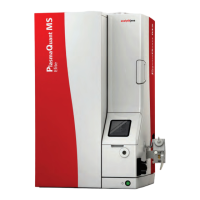Safety instructions PlasmaQuant MS product family
14
Danger of frostbite. The spray chamber and the inner parts of the thermostated
holder assembly may be very cold (≥ -15 °C). Do not touch these parts in normal
operation and directly after operation.
2.5.2 Safety instructions relating to ambient conditions
The PlasmaQuant MS must not be operated in explosion-hazard areas. Smoking or
open flames in the operating room of the PlasmaQuant MS are prohibited! Keep all
combustible materials away from the device.
2.5.3 Safety instructions - electrical equipment
Work on electrical components of the PlasmaQuant MS may only be performed by a
qualified electrical technician according to applicable electro-technical regulations.
Lethal voltages may occur in the device! Contact with live components may cause
death, serious injury or painful electrical shock.
Observe the following notes:
The mains plug must be connected to a proper CEE power socket to ensure that the
device meets protection class I (ground connector). It may only be connected to
power sources whose nominal voltage is the same as that specified on the type
plate of the equipment. The protective effect must not be invalidated by the use of
an extension line which does not have a protective conductor (→ section "Power
supply" p. 32). Never use power cords with faulty or frayed insulation.
The following applies to the installation of the device in North America: When
using the power cable with a NRTL compliant connector, the type of connection
changes to "detachable cordset".
The PlasmaQuant MS and its system components must always be switched off
before being connected to the mains.
Any work on the electronics (within the device enclosure) may only be carried out
by the customer service of Analytik Jena or by a qualified technician authorized by
Analytik Jena.
Before opening the device and for any work on the electronics of the device, use
the circuit breaker on the rear panel to switch the device off. Disconnect the power
plug from the power socket.
2.5.4 Hazards caused by plasma operation
Plasma is extremely hot (> 6,000 K) and emits electromagnetic and UV radiation. The
induction coil is operated with 300 V RMS (and even higher at ignition) and 27 MHz.
High-frequency radiation and UV radiation can cause serious injuries to skin and eyes.
Contact with the torch (plasma torch) shortly after operation will cause skin burns. An
electrical discharge may also occur and cause fatal injuries, electrical shock and skin
injuries.
Shielding around the plasma compartment is designed to reduce UV, visible, and RF
radiation to safe levels while still permitting easy access to the torch when
maintenance is required.

